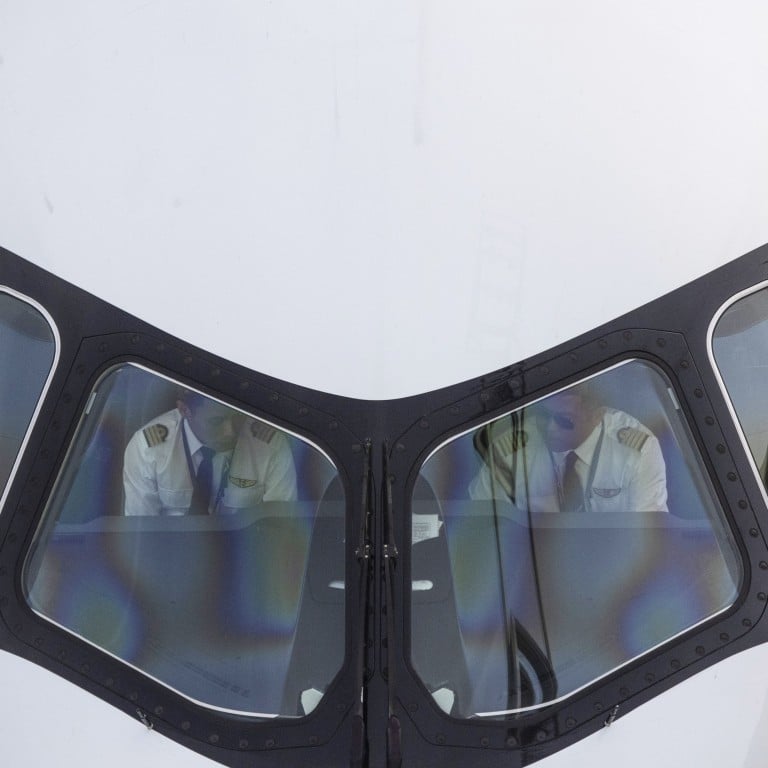
Hong Kong aviation academy, university team up to offer new degree for pilots
- Hong Kong Metropolitan University, Airport Authority’s International Aviation Academy to launch course offering commercial pilot licence from September
- University president Paul Lam says programme includes business management element to offer students chance ‘to explore other directions’
Hong Kong’s first applied science university will launch a new degree programme for aspiring pilots in September, with the course offering a licence at a cost of HK$1 million (US$127,700) in tuition fees.
The new qualification from the Hong Kong Metropolitan University and the Airport Authority’s International Aviation Academy is part of a business administration bachelor’s degree in aviation services management, one aimed at speeding up pilot recruitment.
University president Paul Lam Kwan-sing said on Thursday that the four-year programme would give students the chance to earn two qualifications, saving candidates HK$60,000 compared with pursuing their pilot training separately.
“The aim is to provide students with an additional choice,” he said. “Perhaps after several years as a pilot, some individuals may desire to explore other directions.”
“By undertaking business management courses [in their initial years], they can leverage their work experience and seek new directions for personal growth and development.”
The joint programme will be offered in the next academic year. Students will have the option to pursue cadet pilot training in their third year’s summer semester.
The first batch of students for the joint programme are expected to commence pilot training in May 2025.
The four-year course charges an annual tuition fee of HK$95,000, while students on an income-based government subsidy will pay HK$59,740 per year.
Students opting for cadet pilot courses in their third year must pay an additional tuition fee of HK$740,000, which is HK$60,000 less than the academy’s own programme that launched last November.

The academy’s programme spans 14 months and includes six months of study in the city, followed by another eight months of flight practice in the United States. Students must undergo a minimum of 142 hours of flight training.
The course also offers preliminary interviews for trainees with the academy’s four partnered airlines – Hong Kong Airlines, HK Express, Greater Bay Airlines and Hong Kong Air Cargo – to help students secure conditional job offers.
Cadets must also take a two-week multi-crew cooperation course before they can earn a Hong Kong Commercial Pilot Licence with Instrument Rating (Airplane).
The course received more than 100 applications since the selection process started last September and accepted 31 cadets in two classes. The next class of 20 is expected to start in May. The academy aims to train 100 local cadets each year.
Is it time for Hong Kong authorities to take a stake in Cathay Pacific?
In the United Kingdom, the L3 Harris Academy’s course to secure a UK and European Union commercial pilot license costs £106,560 (HK$1.05 million).
Meanwhile, pilots joining programmes offered by airlines such as Cathay Pacific Airways or British Airways pay off the cost of training through deductions to their salary.
Academy president Simon Li Tin-chu said on Thursday that tuition fees posed a challenge for aspiring pilots, but support from two banks and a finance company meant applicants could take out loans with favourable interest rates.
“Depending on the students’ creditworthiness, the loan schemes may provide a loan of 70 per cent to the full tuition fees, ensuring that students from different backgrounds have the opportunity to pursue this course,” he said.
Li said the joint programme with the university sought to cultivate more local talent and welcome candidates from mainland China and overseas.
Hong Kong’s first university of applied sciences plans to train local pilots
The academy had sufficient resources to fully accommodate students from the joint programme and its own one if the yearly intake for both remained at 100 each, he added.
Manufacturer Boeing last year estimated that 649,000 new pilots would be needed by 2042 to support the global commercial fleet, while 10,000 additional pilots are needed each year in China and Southeast Asia.
Secretary for Transport and Logistics Lam Sai-hung said on Thursday that the collaboration would help solidify Hong Kong’s position as an international aviation hub, while enhancing its influence as a regional training centre.
“We can attract talent from mainland China, Hong Kong and overseas, opening a new chapter in aviation training in Hong Kong and enriching the local offerings in aviation professional training,” he said.
“I believe this is not only good news for aspiring young pilots in the Greater Bay Area and abroad, but also a significant milestone welcomed by the government and industry.”

